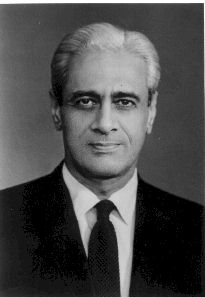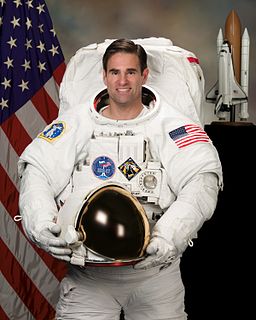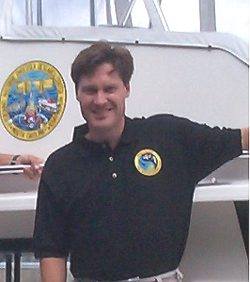Related Research Articles
The Canadian Space Agency is the national space agency of Canada, established in 1990 by the Canadian Space Agency Act. The agency is responsible to the minister of innovation, science, and economic development.
The space-grant colleges are educational institutions in the United States that comprise a network of fifty-two consortia formed for the purpose of outer space-related research. Each consortium is based in one of the fifty states, the District of Columbia, or Puerto Rico, and each consists of multiple independent space-grant institutions, with one of the institutions acting as lead.

Robert Brent "Bob" Thirsk, is a Canadian engineer and physician, and a former Canadian Space Agency astronaut. He holds the Canadian records for the most time spent in space. He became an officer of the Order of Canada (OC) in 2013 and was named to the Order of British Columbia (OBC) in 2012.
The Microvariability and Oscillations of Stars/Microvariabilité et Oscillations STellaire (MOST), was Canada's first space telescope. Up until nearly 10 years after its launch it was also the smallest space telescope in orbit. MOST was the first spacecraft dedicated to the study of asteroseismology, subsequently followed by the now-completed CoRoT and Kepler missions. It was also the first Canadian science satellite launched since ISIS II, 32 years previously.

The American Institute of Aeronautics and Astronautics (AIAA) is a professional society for the field of aerospace engineering. The AIAA is the U.S. representative on the International Astronautical Federation and the International Council of the Aeronautical Sciences. In 2015, it had more than 30,000 members among aerospace professionals worldwide.
As a federal agency, the National Aeronautics and Space Administration (NASA) receives its funding from the annual federal budget passed by the United States Congress. The following charts detail the amount of federal funding allotted to NASA each year over its history to pursue programs in aeronautics research, robotic spaceflight, technology development, and human space exploration programs.

The Florida Institute of Technology is a private research university in Melbourne, Florida. The university comprises four academic colleges: Engineering & Science, Aeronautics, Psychology & Liberal Arts, and Business. Approximately half of FIT's students are enrolled in the College of Engineering. The university's 130-acre primary residential campus is near the Orlando Melbourne International Airport and the Florida Tech Research Park.

The University of Toulouse is a university in France that was established by papal bull in 1229, making it one of the earliest universities to emerge in Europe. Since the closing of the university in 1793 due to the French Revolution, the University of Toulouse no longer exists as a single institution. However, there have been several independent "successor" universities inheriting the name.

The Goddard Institute for Space Studies (GISS) is a laboratory in the Earth Sciences Division of NASA's Goddard Space Flight Center affiliated with the Columbia University Earth Institute. The institute is located at Columbia University in New York City.

Satish Dhawan was an Indian mathematician and aerospace engineer, widely regarded as the father of experimental fluid dynamics research in India. Born in Srinagar, Dhawan was educated in India and further on in United States. Dhawan was one of the most eminent researchers in the field of turbulence and boundary layers, leading the successful and indigenous development of the Indian space programme. He succeeded M. G. K. Menon, as the third chairman of the Indian Space Research Organisation (ISRO) in 1972.

Badges of the United States Air Force are specific uniform paraphernalia authorized by the United States Air Force that signify aeronautical ratings, special skills, career field qualifications, and serve as identification devices for personnel occupying certain assignments.
Institute of Space and Astronautical Science (ISAS) is a Japanese national research organization of astrophysics using rockets, astronomical satellites and interplanetary probes which played a major role in Japan's space development. Since 2003, it is a division of Japan Aerospace Exploration Agency (JAXA).
The University of Tennessee Space Institute, also known as UTSI, is a satellite campus of the University of Tennessee located near Tullahoma, Tennessee.

Gregory Errol Chamitoff is an engineer and former NASA astronaut. He has been to space twice, spending 6 months aboard the ISS across Expedition 17 and 18 in 2008, and another 15 days as part of STS-134 in 2011. STS-134 was the last of Space Shuttle Endeavour which delivered the Alpha Magnetic Spectrometer and completed the US Orbital Segment.
The Universities Space Research Association (USRA) was incorporated on March 12, 1969 in Washington, D.C. as a private, nonprofit corporation under the auspices of the National Academy of Sciences (NAS). Institutional membership in the association currently stands at 113 universities. All member institutions have graduate programs in space sciences or technology. Besides the 98 member institutions in the United States, there are two member institutions in Canada, four in Europe, two in Israel, one in Australia and one in New Zealand, one in Hong Kong, two in Korea and two in the United Kingdom.
Science outreach, also called Education and Public Outreach or simply public outreach, is an umbrella term for a variety of activities by research institutes, universities, and institutions such as science museums, aimed at promoting public awareness of science and making informal contributions to science education.
Byrana Nagappa Suresh is an Indian aerospace scientist. He is presently the Chancellor, Indian Institute of Space Science and Technology, IIST at Thiruvanthapuram and Honorary Distinguished Professor at ISRO HQ. He was President Indian National Academy of Engineering, INAE at Delhi, which is a premier engineering Academy in the Country for four years during 2015 to 2018. He served as the Director of Vikram Sarabhai Space Centre (VSSC), Thiruvananthapuram during the period 2003–2007. He is known for his contribution to the development of Indian launch vehicles, Space Capsule Recovery Experiments (SRE) and also for R& D management. Suresh also served as the founding director of Indian Institute of Space Science and Technology (IIST), Thiruvananthapuram. He retired from IIST in November 2010. He was Vikram Sarabhai Distinguished Professor at ISRO HQ for 5 years since November 2010 and also as distinguished professor at IIT, Mumbai and MIT, Manipal for 3 years. He was a member of the board of governors (BOG) for IIT, Madras for 7years till july 2018. He is also chairman of the governing council for MVJ College of Engineering at Bangalore. He is the vice chair for the Design Division of Aeronautical Society of India. He is one of the associate editors of the book From Fishing Hamlet To Red Planet and a co-author of Ever Upwards: ISRO in Images, both tracing the history of Indian Space Research Organisation.

Marcum "Marc" Reagan is a Station Training Lead in Mission Operations at NASA's Johnson Space Center in Houston, Texas. He leads a team of instructors who together are responsible for developing and executing complex simulations for International Space Station (ISS) assembly and operations. Reagan also serves as an ISS "Capcom" from Mission Control, communicating with ISS astronauts in orbit. In May 2002, Reagan served as an aquanaut on the NASA Extreme Environment Mission Operations 2 crew. He subsequently served as Mission Director for multiple NEEMO missions.
COM DEV International is a satellite technology, space sciences and telecommunications company with headquarters in Cambridge, Ontario, Canada. The company has branches and offices in Ottawa, the United States, the United Kingdom, China and India.
References
- ↑ Website
- ↑ "Website - About Us". Archived from the original on 2014-12-17. Retrieved 2014-12-21.